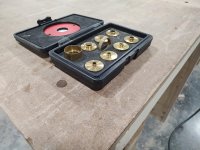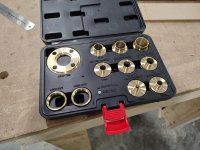onocoffee said:
Thank you all for your thoughts. Guess I will make the trip down to the sheet goods guy once next week's predicted snowfall passes.
[member=74278]Packard[/member] - Not sure just yet, still trying to plan and figure out how I will do what I would like to do. The first project will be to recreate this chair that I was originally refinishing and thought it would make a good project to learn on. The plan is to disassemble it, trace the form onto the board, cut it out and sand the template to the finished dimension.
From there I figure I would trace the pattern onto the wood and rough cut it with a band saw, reattach the pattern and use it with a trim router bit and then shape. But since I have not yet done any of this, I'm still open to best practices.
[…]
I just came home from the eye doctor’s office and the eye drops have not worn off. Everything is still blurry, so please excuse any typos until I rR-read this post tomorrow.
A bringing-it-back-down-to-earth observation:
A number of years ago I read that the average number of hours to build a Craftsman-style chair is 30 to 50 hours per chair.
The average for a Windsor style chair is 40 to 60 hours.
I’ve never built a chair so I cannot evaluate those numbers, but I’m sure there is a FOG member or two that could comment.
So I am just saying that some simpler projects might be tried first…
I personally have built simple stools using pre-fabricated steel legs and woven cane seating. But that is about how ambitious I might be. I am planning on making a similar bench for the foot of my bed.
Before tackling chairs, I would try to assess the scope of the work involved.
I don’t keep track of hours when building stuff. I am trying to reconstruct my hours for this simple stool now.
Prepare the maple boards for the woven cane:
Mill groove for splines
Round over ( x 4)
2 - 4 hours.
Miter + 3 dowels, glue and clamp: 3 - 4 hours.
7 coats of wipe on poly. 2 - 3 hours over several days.
Soak cane in water, glue and insert spline — one stressful hour. Working against the clock as the cane dries it shrinks, so haste is the game.
Attach legs, less than 30 minutes.
So the simplest imaginable chair is 5-1/2 to 7-1/2 hours.
Not trying to discourage you, just trying to add a dash of reality. Chairs, well-made have to have exemplary joinery as. The joints are generally quite small and the demands on those joints are generally quite large.
If it were me, I would try something simpler.
Re-reading my estimated hours, I could be off by 100% plus or minus. Looks like less work, seemed like more while I was doing it.



